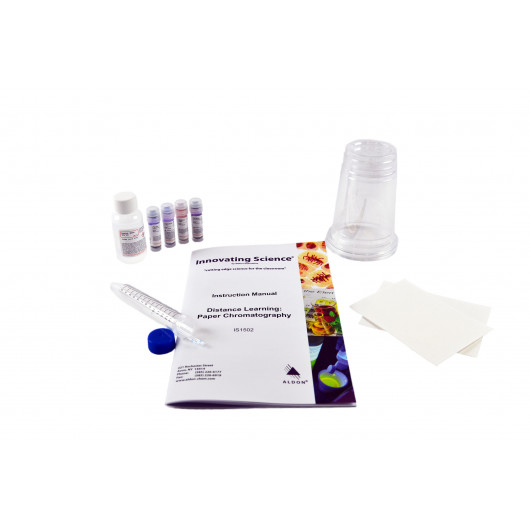Characteristics of Matter Kit SKU: AP 1114
Includes ten experiments exploring the characteristics of matter: Properties of Matter, States of Matter, Physical Properties of Solids, Physical Properties of Liquids, Melting Point, Boiling...


In this activity, students will perform paper chromatography on three individual dyes, along with a mixture of dyes, to determine the composition of the mixture.
Chromatography is the oldest documented technique to separate chemical substances. In this activity, students will perform paper chromatography on three individual dyes, along with a mixture of dyes, to determine the composition of the mixture. Students will understand not only the components of a chromatography system, but also why different substances separate and move at different rates within the system. An Instruction Manual and enough materials for 2 groups are included.
Aligned to the Next Generation Science Standards (NGSS)*
Disciplinary Core Ideas: PS1.A; PS1.B
Performance Expectations: MS-PS1-2; HS-PS1-3
Cross Cutting Concepts: Patterns
Engineering Practices: Analyzing and Interpreting Data; Planning and Carrying Out Investigations
Kit Includes:
WARNING CHOKING HAZARD
Small parts. Not for children under 3 yrs.
DOT Info:
Non-regulated
*”Next Generation Science Standards” is a registered trademark of Achieve. Neither Achieve nor the lead states and partners that developed the Next Generation Science Standards was involved in the production of, and does not endorse, this product.
![]() WARNING: This product can expose you to chemicals including Crystal Violet and Methanol/Methyl isobutyl ketone, which are known to the State of California to cause cancer and reproductive harm. For more information go to http://www.P65Warnings.ca.gov.
WARNING: This product can expose you to chemicals including Crystal Violet and Methanol/Methyl isobutyl ketone, which are known to the State of California to cause cancer and reproductive harm. For more information go to http://www.P65Warnings.ca.gov.
You are sent a comment success. The administrator will review and approve your comment. Thank you!
Includes ten experiments exploring the characteristics of matter: Properties of Matter, States of Matter, Physical Properties of Solids, Physical Properties of Liquids, Melting Point, Boiling...
This activity is a fun, safe way to teach students the effect a catalyst has on a chemical reaction.
In this experiment, students will expose living yeast cells to three different sugars-glucose, sucrose, and lactose.
Introduce students to Chemical Equations as they perform and observe two different single replacement reactions and two different double replacement reactions.
Kit contains enough materials for 15 groups. This kit will introduce two common types of chemical reactions; single replacement and double replacement.
Students will be introduced to acids and bases and test a dilute acid and dilute base with neutral litmus paper to learn how pH strips indicate if something is acidic or basic.
Explore the basic types of chemical reactions, mole ratios, and the stoichiometric equivalents central to chemical calculations.
The activities in this kit focus on developing a better understanding of what is matter and what the different types of properties are

In this activity, students will perform paper chromatography on three individual dyes, along with a mixture of dyes, to determine the composition of the mixture.